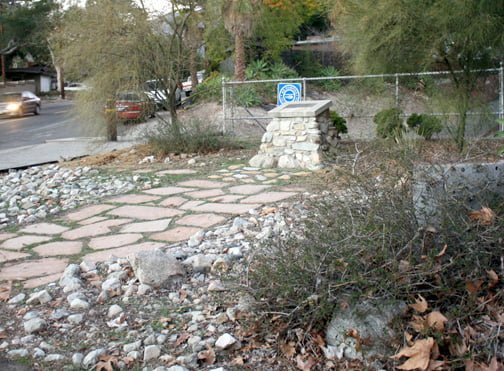
Commemorating the New Year’s Day flood of 1934 is a monument located at the corner of Fairway and Rosemont avenues.
By Jason KUROSU
Flood risks have long been a part of La Crescenta’s history, long before the mudslides after the 2009 Station Fire, and controversies are repeated over the storage and removal of sediment flowing down from the mountainsides. The flood event of greatest magnitude, the New Year’s Day Flood of 1934, has reached the 80-year mark, a tragedy which claimed 32 lives and heightened the collective awareness of the dangers inherent in living beneath the San Gabriel Mountains.
Art Cobery, a resident of La Crescenta for over 70 years, documented the disaster in his book, “The Great Crescenta Valley Flood.” In the book, Cobery weaves first-person accounts of the disastrous night with a history of La Crescenta’s penchant for fire and flood.
“We’re living here, obstructing the course of Mother Nature,” Cobery told CV Weekly. “But sometimes we don’t want to deal with the inconveniences.”
Even with the knowledge of the area’s flood history, the damage Cobery describes in his book is astonishing.
Along with the 32 deaths, Cobery estimates that 50 houses were destroyed (or filled with mud or other debris and thus rendered uninhabitable) and another 50 houses were washed away completely. Scenes in the book describe cars, houses and even boulders weighing upwards of 60 tons being hurled by flood waters through the town with the ease of leaves in a stream, eventually washing up in the middle of streets or even someone’s front yard.
Cobery writes that, for all the destruction, it was only for about a 20-minute period of time that the numerous canyons above La Crescenta emptied their debris upon the town.
“During that short lapse of time,” Cobery writes, “700,000 cubic yards of soil vacated 7.5 square miles of burned-off mountainside. That is enough sediment to fill 77,777 10-wheel dump trucks.”
Since that day, flood measures and flood control efforts have expectedly been intensified, leading to the rebuilding of local debris basins (several debris-related incidents from 1978 also helped prompt these efforts.)
“I think the County Flood Control does a wonderful job,” said Cobery. “But even the best geologists can’t guarantee any community absolute safety.”
However, even with improvements, flood concerns are never dormant and neither is the public’s scrutiny of preventive measures.
Cobery documents the voters’ unwillingness in 1926 to approve a bond measure, which would have strengthened the San Gabriel Dam, possibly preventing the flood of 1934. Unfortunately, the funds for the San Gabriel Dam itself came from a similar voter-approved measure, which did not meet favorably with public opinion due to its size and suspect safety, among other things.
Today, similar county and flood control projects have been debated by nearby residents, who are concerned with the negative impacts of removing sediment. Most recently, the county is looking to haul sediment from the Devil’s Gate Dam at Hahamongna, utilizing dump trucks to transport it from the dam to designated disposal sites. The public has protested the project, primarily the use of trucks, which it contends will be harmful to public health and the environment. Others question the necessity of the project, whether or not the flood risk is truly great enough to require such an endeavor, which authorities estimate could take somewhere between three and five years, starting in 2015.
“No one likes the prospect of trucks,” said Cobery, who remembered trucks removing sediment from debris storage sites at Eagle Canyon, near his home. “I didn’t like it either.”
But in Cobery’s estimation, the debris basins, which he said La Crescenta residents have “relied on,” have done quite well.
A memorial to the flood victims can be seen at the corner of Rosemont and Fairway, a plaque mounted on stones. Cobery said that, despite the magnitude and intensity of the flood, many local residents have never heard of the 1934 New Year’s Day Flood. Though it is important to remember the potential for another flood in the area, along with the heroics, sacrifices and tragedies that befell many that night, it is perhaps not so unfortunate that the 1934 flood is so distant to so many, multiple generations who have not had to know the horror of disaster and devastation.
